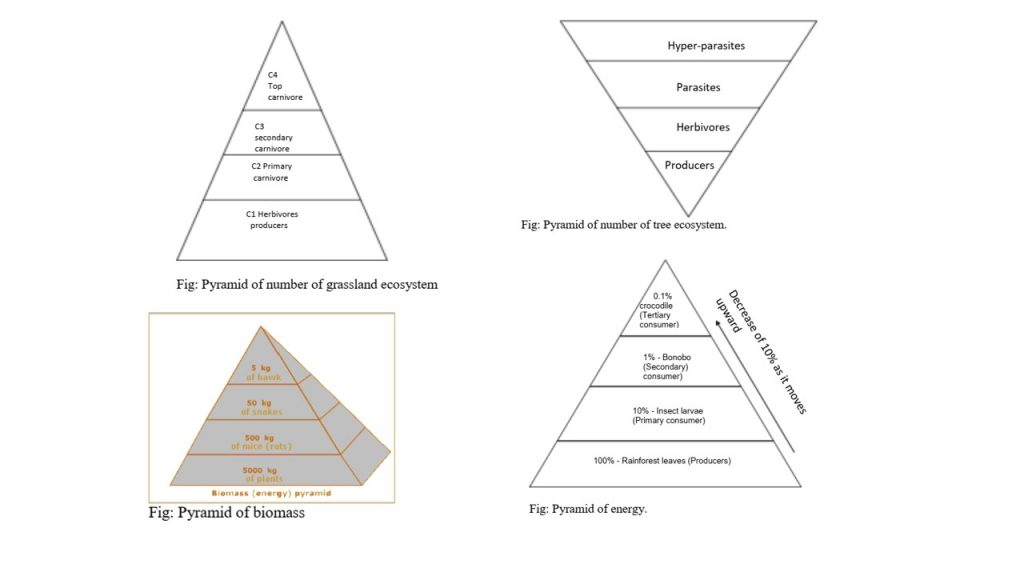
Food chain
- The food chain is an ideal representation of flow of energy in the ecosystem.
- In food chain, the plants or producers are consumed by only the primary consumers, primary consumers are fed by only the secondary consumers and so on.
- The producers that are capable to produce their own food are called autotrophs.
- Any food chain consists of three main tropic levels, viz., producers, consumers and decomposers.
- The energy efficiency of each tropic level is very low. Hence, shorter the food chain greater will be the accessibility of food.
The typical food chain in a ground ecosystem proceeds as grass mouse—————-> snake ————> hawk.
- Food webs are more complex and are interrelated at different tropic levels.
- Organisms have more than one choice for food and hence can survive better.
- Hawks don’t restrict their food to snakes, snakes eat animals other than mice, and mice eat grass as well as grasshoppers, and so on.
- A more realistic illustration of feeding habits in an ecosystem is called a food web.
Food web:
- Charles Elton presented the food web concept in year 1927, which he termed as food cycle.
- Charles Elton described the concept of food web as:
- The carnivore animals prey on the herbivores.
- These herbivores obtain the energy from sunlight.
- The later carnivores may also be preyed upon by other carnivores.
- Until a reach where an animal has no enemies it forms a terminus on this food cycle.
- There are chains of animals that are related together by food, and all are dependent on plants in the long run.
- This is termed as a food chain and all the food chains in a community is known as the food web.
- A food web is a graphical depiction of feeding connections among species of an ecological community.
- Food web includes food chains of a particular ecosystem.
- The food web is an illustration of various techniques of feeding that links the ecosystem.
- The food web also explains the energy flow through species of a community as a result of their feeding relationships.
- All the food chains are interconnected and overlapping within an ecosystem and they constitute a food web.
- In natural environment or an ecosystem, the relationships between the food chains are interrelated.
- These relationships are very complex, as one organism may be a part of multiple food chains.
- Hence, a web like structure is formed in place of a linear food chain.
- The web like structure if formed with the interlinked food chain and such matrix that is interconnected is known as a food web.
- Food webs are an inseparable part of an ecosystem; these food webs permit an organism to obtain food from more than one type of organism of the lower trophic level.
- Every living being is responsible and is a part of multiple food chains in the given ecosystem.
Ecological pyramids:
- The trophic levels of different organisms based on their ecological position as producer to final consumer is represented by ecological pyramid.
- The food producer is present at the base of the pyramid and on the top.
- Other consumer trophic levels are present in between.
- The pyramid includes a number of horizontal bars presenting specific trophic levels.
- The length of each bar stands for the total number of individuals or biomass or energy at each trophic level in an ecosystem.
- An ecological pyramid is a graphical representation outlined to show the biomass or bio productivity at each trophic level in a given ecosystem.
- These are trophic pyramid, energy pyramid, or sometimes food pyramid.
- Biomass is the quantity of living or organic matter present in an organism.
- Biomass pyramids represent the amount of biomass, and how much of it is present in the organisms at each trophic level.
- The productivity pyramids shows the production or turnover in biomass.
- Ecological pyramids initiates with producers on the bottom such as green plants and proceed through the various trophic levels such as herbivores that feed on plants, then carnivores that feed on herbivores, then carnivores that feed those carnivores, and so on.
- The highest level is shown at the top of the chain.
- An ecological pyramid of biomass represents the relationship between biomass and trophic level by quantifying the biomass present at each trophic level of an ecological community at a particular time.
- It is a graphical representation of biomass present in per unit area in different trophic levels.
- Flow of energy through the food chain will be in a predictable way, entering at the base of the food chain, by photosynthesis in primary producers, and then moving up the food chain to higher trophic levels.
- The transfer of energy from one trophic level to the next is not efficient.
- It may also be useful and productive to analyse how the number and biomass of organisms differs across trophic levels.
- Both the number and biomass of organisms at each trophic level should be affected by the amount of energy joining that trophic level.
- When there is a direct correlation between energy, numbers, and biomass then biomass pyramids and numbers pyramids will be formed.
- However, the relationship between energy, biomass, and number can be complex by the growth form and size of organisms and ecological relationships occurring among trophic levels.
Types of pyramids:
- The ecological pyramids are of three categories:
- Pyramid of numbers.
- Pyramid of biomass.
- Pyramid of energy or productivity.

1. Pyramid of numbers:
- Pyramid of numbers represents the population of trophic level as the total number of individuals of different species present at each trophic level.
- Pyramid of numbers may be upright and or completely inverted depending upon count of individual present and so.
- The pyramid of number does not completely define the trophic structure for an ecosystem as it is very tough to count all the organisms present there.
- Pyramid of number- upright: grassland ecosystem
- In this pyramid, the number of individuals is decreased from lower level to higher trophic level.
- The examples of pyramid of numbers are Grassland ecosystem and pond ecosystem.
- In grass ecosystem, at base (lowest trophic level) grass is present in plentiful amount.
- The next higher trophic level is primary consumer i.e. herbivore (example – grasshopper).
- The number count of grasshopper is less than that of grass.
- The next energy level is primary carnivore (example: rat). The number of rats are less than grasshopper, because, they feed on grasshopper.
- The next higher trophic level is secondary carnivore (example: snakes). They feed on rats.
- The next higher trophic level is the top carnivore. (example – Hawk).
- As we reach each higher trophic level, the numbers of individual decreases from lower to higher trophic level.
- Pyramid of numbers – inverted: tree ecosystem
- In this type of pyramid, the number of individuals is increased from lower level to higher trophic level. Example, tree ecosystem.
2. Pyramid of biomass:
- Pyramid of biomass represents the total dry weight of organisms.
- It is usually determined by collecting all organisms inavding each trophic level separately and measuring their dry weight.
- This will serve to solve the size difference problem because all kinds of organisms at a trophic level are weighed.
- The unit for measurement of biomass is g/m2.
- The biomass of a species is expressed in terms of fresh or dry weight.
- Measurement of biomass in terms of dry weight is considered more accurate.
- Certain mass of living material of each trophic level at a particular time called as standing crop.
- The standing crop is measured as the mass of living organisms (biomass) or the number in a unit area.
- pyramid of biomass: upright
- The pyramid of biomass on land contains a large base of primary producers with a lesser trophic level present on top.
- The biomass of producer termed as autotrophs is at the maximum trophic level.
- The biomass of next trophic level from base, i.e., primary consumers is less than the producers.
- The biomass of next higher trophic level, i.e., secondary consumers is less than the primary consumers.
- The top, high trophic level consists very less amount of biomass.
- On other hand, in many aquatic ecosystems, the pyramid of biomass may be present in an inverted form whereas pyramid of numbers for aquatic ecosystem is upright.
- It is because the producers are small phytoplankton that grow and reproduce very rapidly.
- Here, the pyramid of biomass has a small base as compared to the consumer biomass at any instant actually exceeding the producer biomass and the pyramid is represent in inverted shape.
3. Pyramid of energy:
- The pyramid of energy represents the flow of energy from lower trophic level to higher trophic level.
- During the flow of energy from one organism to other, there is remarkable loss of energy.
- This loss of energy is in the form of heat.
- The primary producers like the autotrophs contain more amount of energy available.
- The least energy is available in the tertiary consumers.
- Thus, shorter food chain has more amount of energy available even at the highest trophic level.
- An energy pyramid is regarded most suitable to compare the functional roles of the trophic levels in an ecosystem.
- An energy pyramid represents the amount of energy at each trophic level and loss of energy taking place during transfer to another trophic level.
- Hence the pyramid is always upward, with a large energy base at the bottom.
- Suppose an ecosystem receives 1000 calories of light energy in a given day.
- Most of the energy is not absorbed by plants; some amount of energy is reflected back to space.
- Green plants utilise only a small portion of that absorbed energy, out of which the plant uses up some for respiration and of the 1000 calories, only 100 calories (10%) are stored as energy rich materials.
- Now, suppose an animal eats the plant containing 100 calorie of food energy, that animal uses some of it for its own metabolism and stores only 10 calorie as food energy.
- A lion that eats that animal gets an even smaller amount of energy.
- Thus, usable energy decreases while passing from sunlight to producer to herbivore to carnivore. Therefore, the energy pyramid will always be upright.
